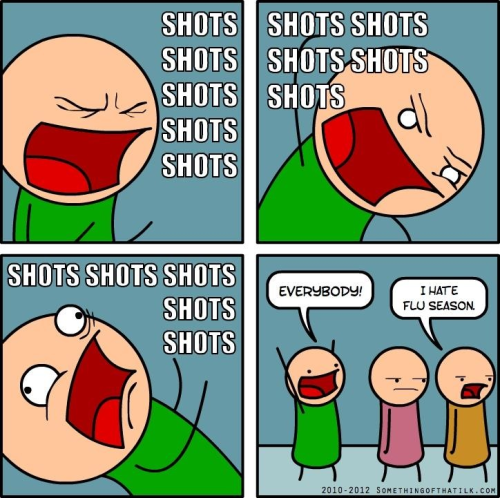Throughout history, the influenza virus has proven to be
highly problematic for human beings. Various
epidemics have spread across the globe and taken many lives, including the
recent avian flu (H5N1) and swine flu (H1N1).
While the virus itself does cause a lot of harm, it is often pneumonia
caused by Staphylococcus aureus (S. aureus), which results from the
influenza infection, that often proves to be fatal (1). Virologists have been looking for a vaccine
that would help not only to prevent influenza infection, but also to deter S. aureus infection. In their journal article, Dai et al. explain how they found a conserved
section of the protein HA which can be made into a vaccine and coupled with the
bacterial antigen Ag85A to do just that.
The HA protein
in Influenza A Virus (IAV) holds domains necessary for viral attachment to host
cells. To activate this protein, the
virus cleaves it into two domains: HA1 and HA2.
The host often deploys an immune response that targets antibodies to the
HA protein, which prevents IAV virions from attaching to the host cells (2). While this is temporarily affective, IAV
tends to evolve very rapidly, so vaccines geared towards the HA protein become
outdated very quickly (3). However, the
HA2 domain has been seen to remain highly conserved over virus generations, and
the majority of the mutations can be attributed to the HA1 region. Therefore, it seems reasonable that if
antibodies were made to target the HA2 region specifically, then they would be
able to be effective for longer periods of time (4).
Ag85A is an
antigen secreted by the bacteria Mycobacterium
tuberculosis (M. tuberculosis). As a vaccine, Ag85A was known to increase the
production of T helper 1 (TH1) cytokine responses to M. tuberculosis (5), which in turn lead to an increase in the
expression of toll-like receptor 2 (TLR2).
TLR2 recognizes molecules specific to Staphylococcus species and
activates immune responses to them (6).
Therefore, Ag85A could act as a vaccine for S. aureus. Dai et al. hypothesized that combining the
HA2 domain of the HA protein and Ag85A into a single vaccine would create both
an effective antibody response to IAV and antibacterial response to S. aureus, preventing both influenza and
the potentially lethal pneumonia that tends to follow.
To create
the vaccine, the researchers put the genes for HA and Ag85A onto one plasmid,
and inserted it into cells. Both genes
were successfully expressed in these cells. Once they confirmed that the two
genes could be expressed, they tested the vaccine’s effect on mice. Compared to mice without any vaccination,
mice that had the vaccine produced many more HA neutralizing antibodies. There were also much higher levels of
cytokines and TLR2 produced in these mice after they were infected with S. Aureus. Overall, the vaccinated mice exhibited much
less weight loss and had a higher survival rate when introduced to IAV and S. aureus than those that were not
vaccinated.
An interesting secondary discovery
found by Dai et al. was that there
were more antibodies for HA produced in mice vaccinated with both HA and Ag85A
than those that were vaccinated with just HA.
This suggests that Ag85A may have an antiviral effect on IAV. This possibility should be the subject of
future studies.
The creation of this vaccine could
prove to be a large step in preventing future influenza epidemics. Because this vaccine acts on a highly
conserved influenza protein, it may be able to work against novel influenza
strains that evolve or jump the species barrier. Also, annual or seasonal flu shots may no
longer be necessary, as the vaccine will be able to remain effective for longer
periods of time. Not only does this
provide extra convenience, but it makes influenza treatments easier, as people
will only have to pay for one shot instead of many. This will allow those who may not normally be
able to afford flu shots to receive vaccinations, leading to increased human
health across the world.
Primary Source:
Dai J, Pei D, Wang B, Kuang Y, Ren L, Cao K, Zuo B, Shao J,
Li S, Jiang Z, Li H, Li M: “A novel DNA vaccine expressing the Ag85A-HA2 fusion
protein provides protection against influenza A virus and Staphylococcus
aureus.” Virology Journal 2013,
10:40.
Supporting Articles:
(1) Tsigrelis C, Mohammad M, Fraimow HS, Dellinger RP,
Marchesani D, Reboli AC:
“Secondary bacterial pneumonia due
to Staphylococcus aureus complicating 2009
influenza A (H1N1) viral
infection.” Infection 2010,
38(3):237–239.
(2) Chandran SS, Verhoeven D, Teijaro JR, Fenton MJ, Farber
DL: “TLR2 engagement on
dendritic cells promotes high
frequency effector and memory CD4 T cell responses.” J
Immunol
2009, 183(12):7832–7841.
(3) Kim JH, Skountzou I, Compans R, Jacob J: “Original
antigenic sin responses to influenza
viruses.” J Immunol 2009, 183(5):3294–3301.
(4) Sui J, Hwang WC, Perez S, et al: “Structural and
functional bases for broad-spectrum
neutralization of avian and human
influenza a viruses.” Nat Struct Mol Biol
2009,
16(3):265–273.
(5) Romano M, Roupie V, Hamard M, Huygen K: “Evaluation of
the immunogenicity of
pBudCE4.1 plasmids encoding
mycolyl-transferase Ag85A and phosphate transport
receptor PstS-3 from Mycobacterium
tuberculosis.” Vaccine 2006,
24(21):4640–4643.
(6) Holley MM, Zhang Y, Lehrmann E, Wood WH, Becker KG, Kielian
T: “Toll-like receptor
2 (TLR2)-TLR9 crosstalk dictates
IL-12 family cytokine production in microglia.” Glia
2011, doi:10.1002.

No comments:
Post a Comment